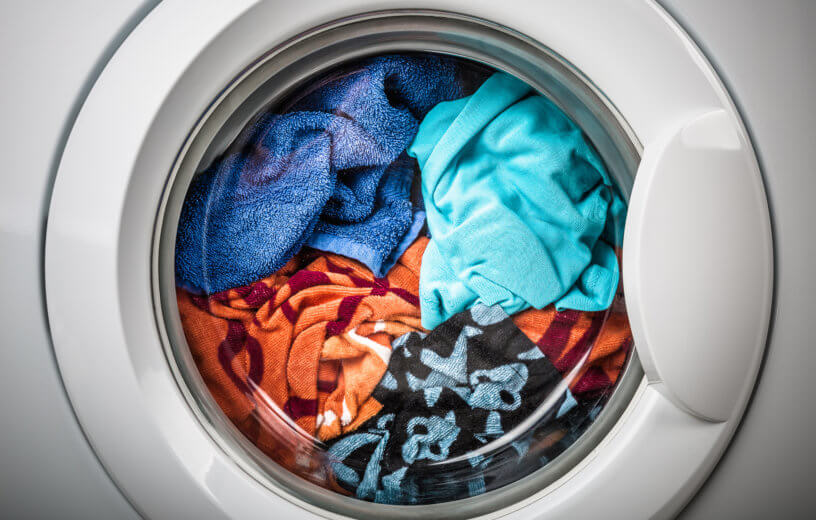LEEDS, United Kingdom — Washing machines could be releasing fibers weighing the same as 1,500 double-decker buses each year in the United Kingdom alone, a new study finds. Microfibers – tiny artificial fibers which enter the environment while making or cleaning clothes – are a major source of water pollution in rivers and oceans across the globe.
The harmful microplastics are thinner than a human hair and invisible to the naked eye. They absorb toxic chemicals that marine wildlife then consumes. The new research shows the main contributing factors to the amount of microfibers shedding in the wash lie in the ratio of clothes to water and the material the clothes are made from.
Academics at the University of Leeds’ School of Design co-created an innovative test to measure how different materials and conditions affect the amount of microfibers released into water whilst washing clothes. The test, funded by the trade body the European Outdoor Group (EOG) and sustainable textiles organization The Microfiber Consortium (TMC), estimates that between 6,860 and 17,847 tons of microfibers enter the environment each year.
The globally aligned test method which resulted from the collaborative project has already been adopted by U.S. and European Union standard bodies due to its reliability. Researchers used a “Gyrowash” during their study. This device replicates a domestic washing machine in lab conditions to test 16 common fabrics, different yarn types, and the conditions of a wash, including the size of the load and how much the machine shakes.
Should people put more clothing in the washing machine?
The study, published in the journal Environmental Science and Pollution Research, finds that over two times the amount of microfibers are released when the ratio of water to clothing doubles, as the water flows more freely through the machine and dislodges loose material.
However, the researchers pointed out that overfilling a washing machine can also lead to safety concerns, as well as reducing the quality of the wash. The test further highlights the impact the agitation of washes (how much the machine shakes the clothes around) has on the amount of microfibers shed. Researchers discovered that the more your washing machine shakes, the more microfibers come off of clothing.
The team made a third observation that microfiber loss reduced significantly following a new item of clothing’s first wash. However, this “levelled out” after three washes. Past estimates had been based on the results of only new fabrics being washed, meaning these latest findings suggest less microfibers are being lost than previously thought.
The new research also shows that fabric characteristics, concerning yarn type, whether clothes are knitted or woven, and the types of fibers used are more influential than washing conditions on the amount of microfibers polluting the environment. Chenille polyester fabric appears to be the worst material for shedding microfibers. Meanwhile, fabrics which had been brushed or peached – the method used to give clothes the feeling of fur on a peach – lost less material.
Based on the organizations’ tests, the annual microfiber release from washes in the United Kingdom alone is equivalent to the weight of between 600 and 1,500 double-decker buses. However, this pollution is still dwarfed in comparison to the fashion industry’s waste problem, which is estimated to contribute 360,000 tons of clothing to landfills each year.
‘We shouldn’t assume some fabrics are worse than others’
Alice Hazlehurst, a lead author of the study and postgraduate researcher at the University of Leeds’ School of Design, hails the new test as an “important step” in understanding microfiber pollution.
“We used a reliable testing method to compare microfiber release from different fabrics and under different washing conditions in the lab. Based on our results we were able to estimate the quantity of microfiber release at a realistic scale,” the researcher says in a university release.
“Quantifying microfiber release is an important step in understanding the scale of the problem, as well as the potential impacts of this form of pollution. There are already lots of estimates out there, but these vary dramatically and it’s almost impossible to make meaningful comparisons.”
“Ultimately, the research shows that fabric choice is complex and we shouldn’t assume some fabrics are worse than others,” adds Dr. Mark Sumner, a lecturer at the School of Design.
Study authors hope the collaborative microfiber test can help international clothing brands more accurately test garments on their microfiber release, as well as inform washing machine manufacturers on filtering.
“The Microfiber Consortium has actively driven for a globally aligned test method that can be used by the textile industry to measure fiber fragmentation from finished fabrics,” says Dr. Kelly Sheridan, research director at TMC.
“The TMC Test Method was the foundation for the development of an international ISO standard, which is testament to its accuracy and reliability. Consequently, microfiber loss data generated from this method can supersede that of previous quantification estimates that have used inconsistent test methodologies.”
South West News Service writer James Gamble contributed to this report.

